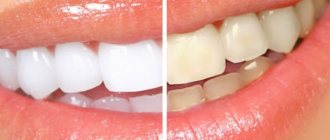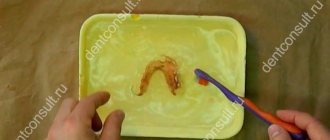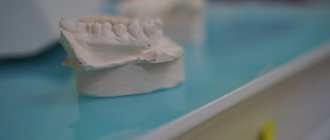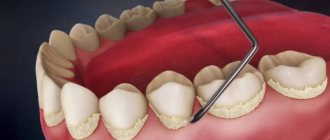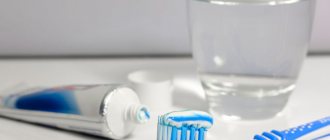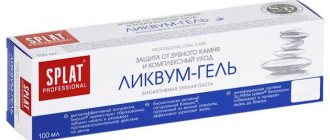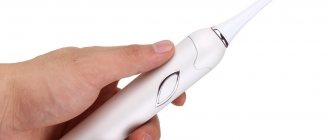Ultrasonic teeth cleaning is one of the safest and most gentle methods of deep teeth cleaning. Even if you systematically and carefully take care of your oral health, over time, plaque, pigmentation and very hard tartar will still form on your teeth, the removal of which is impossible without dental care.
The activity of bacteria causes the appearance of an acidic environment in places where microorganisms accumulate, which leads to bad breath, the formation of caries, bleeding and inflammatory processes of the gums and the active growth of stones that can penetrate into the space under the gums. As a result, the ligamentous apparatus of the tooth is destroyed and periodontal pockets are formed, the teeth become loose and begin to fall out. In addition, the formation of tartar and the growth of pathogenic bacteria in the oral cavity can cause diseases of the gastrointestinal tract, heart and respiratory system. To prevent and treat these problems, professional cleaning methods are used using special devices that do not damage tooth enamel and do not take much time.
What is tartar and what are the causes of its appearance?
Tartar is hardened plaque that forms on the visible part of the tooth (crown) and under the gum.
The reasons for its appearance are natural, but the consequences can cause pathologies in the oral cavity.
Initially, food particles stick to the enamel. Bacteria begin to actively multiply in them. A dental plaque is formed, which looks like a soft, light plaque. Plaque can be easily removed by regular tooth brushing. But if this does not happen, then food debris, dead cells of the mucous membrane, calcium and phosphorus salts from saliva are layered on the soft plaque. They crystallize and harden.
Mineralization occurs on average within 12 days. Soft plaque turns into hard plaque. Tartar has a rough surface, onto which more and more elements “cling.”
Attention: A bacterial film on teeth forms within 16 hours. Therefore, it is important to brush your teeth at least twice a day.
Photo of plaque, male jaw
Why hard deposits form
Plaque formation is inevitable, but there are a number of factors that accelerate the process:
- Irregular hygiene. Particularly active formation of plaque and stone occurs at night: salivation decreases, a person swallows less often, and does not move the tongue. This creates a favorable environment for bacterial growth.
- Poor hygiene. Brushing teeth with horizontal movements does not affect hard-to-reach areas. The interdental spaces should be cleaned by moving the brush vertically.
- Diet. A large amount of sweet and starchy foods leads to the sticking of carbohydrates to the enamel and the proliferation of pathogenic microflora. To reduce the rate of plaque formation, you should eat fresh, firm vegetables and fruits. Chewing the fibrous pulp for a long time partially helps remove plaque.
- Physiological features. Incorrect bite and crowded teeth make proper cleaning difficult.
- Metabolic disorders. The composition of saliva changes, its bactericidal properties decrease.
- Smoking. Cigarette tar settles on the teeth, causing the formation of films and plaques.
Why is ultrasonic cleaning necessary?
Professional teeth cleaning in a clinic identifies problem areas and helps avoid future diseases.
- Detects caries. The destruction of enamel and dentin can be hidden under a layer of tartar. If caries is discovered later, it should be cured.
- Prevents the formation of new caries, including those who wear braces.
- Prevents gum inflammation, periodontitis, exposed roots, bleeding, and bad breath.
- Prepares the oral cavity for surgery and implant installation. Removing colonies of bacteria living in dental plaque ensures the safety of manipulations that violate the integrity of tissues.
- Brightens teeth without aggressive chemical whitening.
Photos BEFORE and AFTER cleaning
Description of the method
Tartar is nothing more than a hard plaque formed from food debris, dead cells, bacteria and salts, which give it a dark tint, which has a very bad effect on the appearance of the teeth. It is impossible to remove it mechanically due to its density and very strong adherence to the teeth. Chemical cleaning methods are also not always acceptable, since there is a risk of destruction of tooth enamel. The ultrasonic method allows you to remove tartar completely safely, completely cleaning your teeth, including periodontal pockets, and restoring their natural color.
For professional teeth cleaning in a clinic, a special device is used - a scaler that creates ultrasonic waves. In this case, the frequency of their oscillations can be adjusted. The targeted delivery of ultrasonic pulses has a mechanical effect on the stones and destroys them.
Is ultrasonic teeth cleaning harmful?
Ultrasonic cleaning does not pose any threat to teeth and the body as a whole. An exception is situations in which the technology is broken or the patient has contraindications. Ultrasound can damage enamel if it is thinned or has such a structural feature. Sometimes brushing causes bleeding from the gums. The doctor will help stop it and advise what needs to be done for speedy healing.
Advice: to avoid possible troubles, before starting the procedure, the dentist finds out the state of health, concomitant diseases, and reaction to medications. Answer honestly and directly, every nuance matters.
Flaws
Despite these advantages, the procedure has disadvantages:
- when working with the device, it is possible to injure the soft tissues of the oral cavity, so the procedure should only be performed by a highly qualified specialist;
- in some cases it is impossible to remove the stone from all sides;
- For sensitive teeth, local anesthesia will be required.
In addition, ultrasonic teeth cleaning has a number of contraindications.
Note. Sometimes dental clinics use scalers, which, when rotated, can damage tooth enamel. Before you sign up for a procedure, check with the administrator what model of device the dentist will use. If the device is outdated, it is better not to take risks and abandon the procedure.
Pros and cons of ultrasonic tartar removal
Unlike other methods, ultrasonic cleaning has a number of advantages:
- Removes subgingival calculus that is difficult to reach with traditional instruments. To clean the root zone, the doctor pulls back the gums and works with the neck and root of the tooth.
- Cleans the interdental spaces even of very dense teeth, uneven, overlapping one another.
- The procedure does not last long - 40-60 minutes.
- Painless. The patient does not feel any impact.
- Non-contact influence. Only air and water come into contact with teeth. With the outdated mechanical method, the instruments scratch the enamel and cause an unpleasant “grinding” sensation.
Main stages of ultrasonic processing
The dentist conducts an examination, identifies places where tartar accumulates, the amount, and determines its density in order to choose the appropriate cleaning regimen. Sometimes teeth are treated with a special solution that reveals the boundaries of plaque. If the patient has sensitive teeth, gums or deep subgingival calculus, anesthesia (injection or application) is performed.
Stone removal is carried out in three stages:
Brushing teeth with a skyler
Skyler is a dental instrument that generates ultrasonic air vibrations. Water (an antiseptic solution) mixed with air is sprayed through a narrow nozzle. The liquid is intended to cool the tooth and wash away the separated plaque.
The ultrasonic wave forms cavities in mineralized deposits, the plaque cracks and peels off from the enamel. The fragments are removed with a saliva ejector.
First, the doctor cleans the crowns, then the subgingival area, guiding the scaler with parallel vertical movements.
Brushing teeth with a skyler
Polishing
Cleaned teeth have a rough surface. To slow down the adhesion of food and bacteria, polishing is used.
Main types:
- Mechanical with special paste and a round elastic brush. The interdental spaces are polished with thin strips or narrow spiral-shaped brushes.
- Hardware using the AirFlow method - using a powerful jet of water with an abrasive containing sodium bicarbonate.
Brushing your teeth with a special paste and a round brush
Fluoridation
Fluoridation helps strengthen enamel and reduce hyperesthesia (sensitivity) in the cervical area.
- The tooth surface is dried with a stream of warm air for better adhesion.
- Apply a composition containing fluoride ions (gel or varnish) and dry again.
- The teeth are treated with a swab soaked in copper hydroxide and calcium solution. The substances enter into a chemical reaction, and calcium fluoride crystals are formed in the dentinal tubules and other irregularities, which strengthen the tooth tissue and prevent infection.
Indications for use
Almost every adult needs ultrasonic teeth cleaning to prevent the formation of dental plaque, but there are categories that are recommended to perform the procedure first:
- Patients preparing for caries treatment and teeth whitening, installation of implants, braces, dentures;
- Patients after removal of braces;
- Patients with installed implants, crowns (special plastic attachments are used for cleaning);
- Patients diagnosed with gingivitis or periodontitis.
Contraindications
The most important contraindication is the presence of a pacemaker in the patient. Ultrasonic waves can disrupt its operation.
Other restrictions also apply to health conditions:
- asthma, bronchospasm, tuberculosis,
- increased risk of bleeding,
- allergies to the drugs used,
- infectious and viral diseases,
- oncology,
- mental illness, epilepsy.
Attention: Relative contraindications are pregnancy (first trimester), childhood (up to 16-18 years). The decision to perform the procedure is made by the dentist.
When it might be painful or unpleasant
Ultrasonic cleaning is a modern, effective method with minimal trauma. Most patients tolerate the process without discomfort.
Pain when cleaning with ultrasound
Pain can occur due to individual characteristics or due to erroneous actions of the doctor.
Features include thin, sensitive enamel - a semblance of shocks and pressure is felt. Weakened gums that are prone to bleeding are easily subject to microdamage and painful sensations appear. If there is extensive subgingival calculus, the doctor works in this area for a long time, which can also lead to discomfort.
Is there any discomfort during laser cleaning?
This method does not cause pain. The laser beam destroys pigments and evaporates water in hard and soft deposits. Their remains are washed off from the surface with water. In this case, there is no effect on the enamel. Gum pockets are not treated with laser; therefore, there is no contact with soft tissues.
Features of chemical tartar removal
The method is rarely used, because has few advantages, including speed and affordable price. Chemical removal has more disadvantages: thinning of the enamel, possible burns of the mucous membrane if performed incorrectly, poor cleaning of the interdental space, allergies to the products used, oxidation of orthodontic metal structures.
Sequencing:
- installation of protective plates on the gums,
- applying acidic and alkaline compounds for 2-3 minutes,
- rinsing, polishing, fluoridation.
Chemical removal of tartar
How painful is it to remove stone manually?
This contact method can only be painful if the doctor's hand accidentally slips and the instrument scratches the gum. Also, the disadvantages include incomplete removal of plaque and stone in hard-to-reach places. Mechanical cleaning is contraindicated for thin, sensitive enamel, inflammation of the gums, and infectious lesions of the mucous membrane.
Nowadays, dentists recommend removing tartar manually less and less often.
During professional cleaning, plaque is removed from gum pockets
At first glance, pockets in the gums may not be noticeable. If their depth is up to 1–2 mm, they do not cause concern. But with age, the gum line drops a little, and the neck of the tooth (root part) is exposed. Plaque accumulates in the pocket, causing inflammation.
Cleaning gum pockets is a separate treatment procedure. But with professional dental hygiene, prevention is carried out: Air Flow removes everything that has begun to accumulate in the pockets, preventing them from deepening.
Professional hygiene removes plaque from gum pockets

